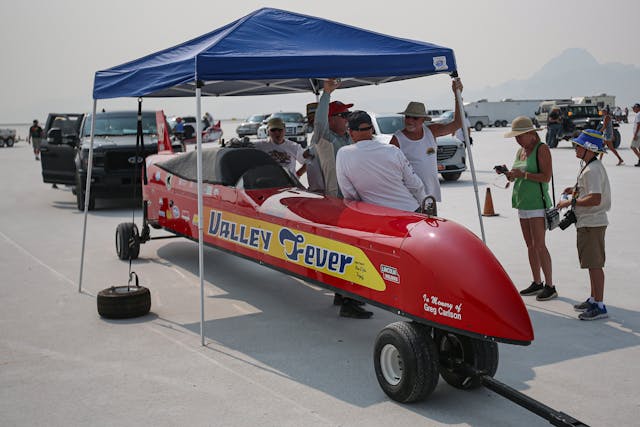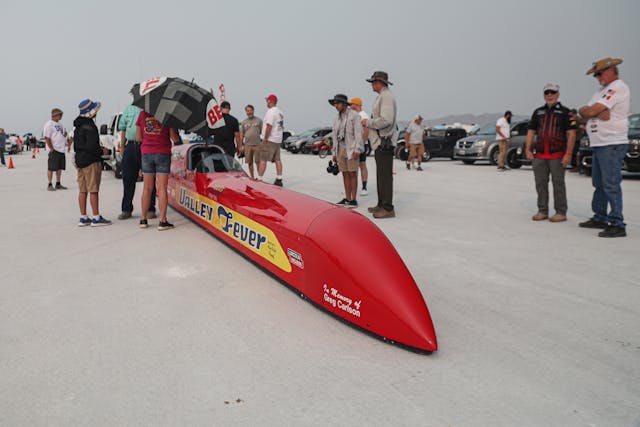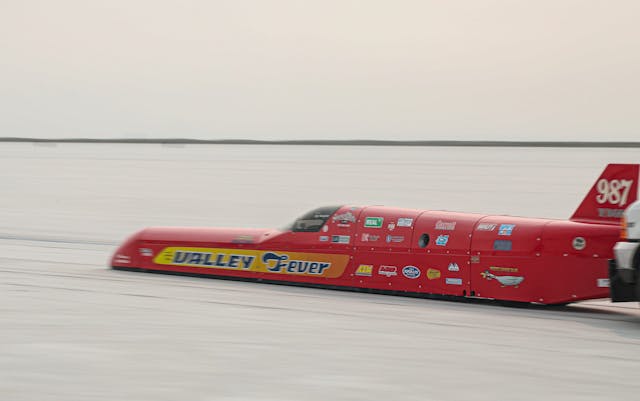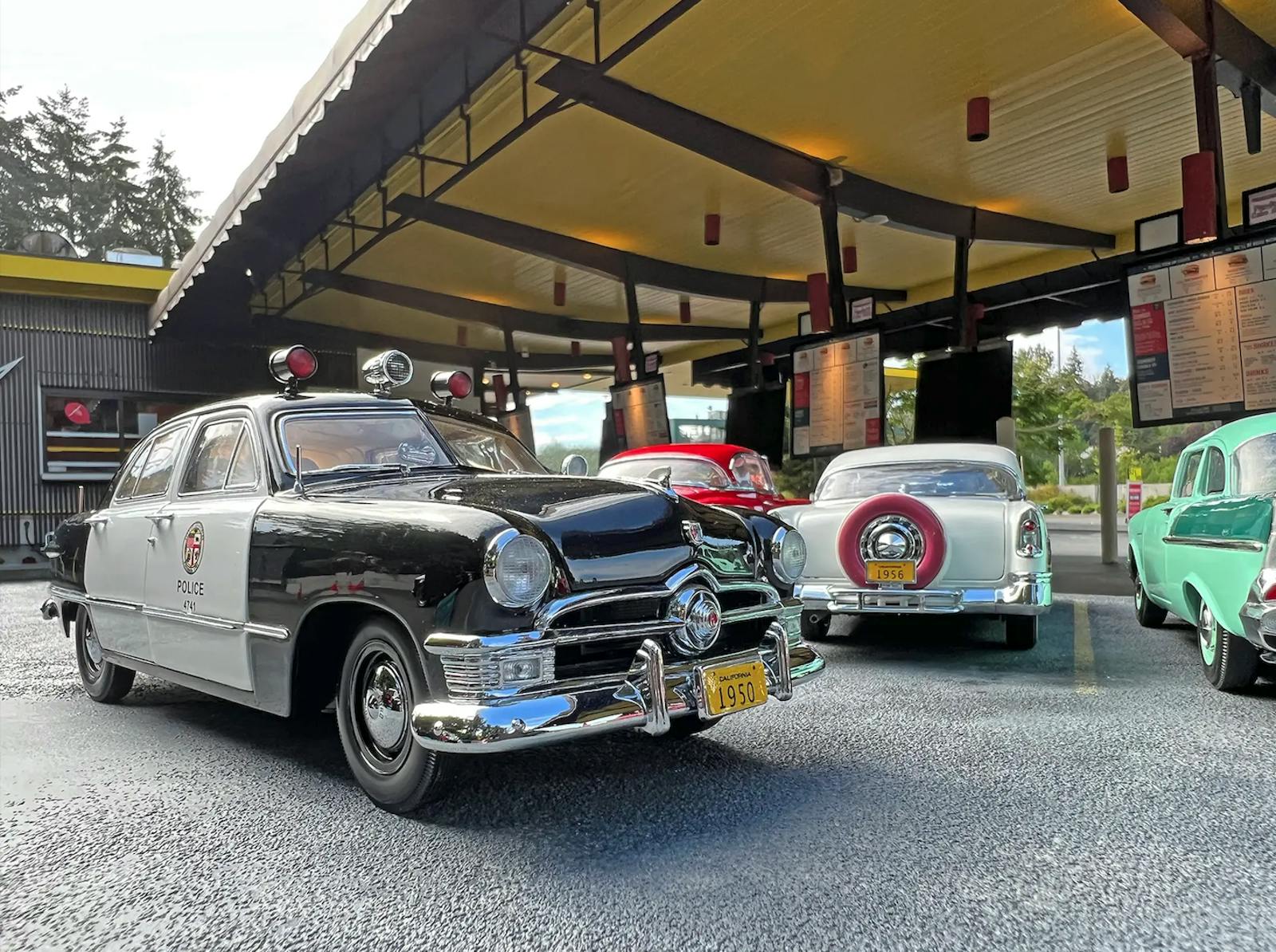Jay Meagher: The humble madman behind the world’s fastest Toyota 2JZ
The pursuit of speed is different for everyone. Many folks who end up “making it” in some way or another are often burdened by deeply personal goals. Ego is as much a motivator as it is a hindrance, but for Jay Meagher, it runs parallel to his own natural curiosity.
Meagher is the owner and operator of Real Street Performance in Sanford, Florida, a shop that specializes in, among other things, belligerently fast Supras powered by the venerable 3.0-liter 2JZ, Toyota’s inline-six darling that has risen to legendary status as one of the most power-capable import tuning foundations on the planet. Recently, Meagher worked his way up from the SCTA’s 200mph Club into its coveted, blue-hat, 300mph Club behind one of his own 2JZ-derived “RS1600” motors.
View this post on Instagram
While this is a unique technical achievement for Toyota’s mill, Meagher is quick to dismiss the title of Builder of the World’s Fastest 2JZ. An innovator by necessity, he brings a unique perspective to land-speed racing as a racer and builder who has conquered the sport of drag racing on a path that decided to settle problems instead of bets alone. His entry into one of the most exclusive worlds in motorsports hinged on innate capability instead of the advertised sort. These kinds of racers and minds don’t open up on their own, so we decided to poke Meagher to see what made him want to step across party lines to pursue land-speed racing.
A notice to readers: Comments on new Hagerty articles have been disabled due to technical issues since July 29th. Don’t worry, the comments are coming back soon, and when they do, we’ll have a contest or giveaway to reward our readers for their patience. Never stop driving! — Jack Baruth
For those who don’t know, how did you get your start with Real Street?
From about [age] 17 to 27, I had been working on Mustangs before starting Real Street. It kind of gave way to imports, because if you built a Ford engine, it paid this amount of money. And if you built a Subaru engine, it paid the same amount of money but it was less work. So I started doing Subaru stuff because nobody in the area wanted to do it and there was a lot to be done. That kind of gave way to having a Supra, and I started working on a few Supras, and it snowballed into partnering with guys in 2009 that were into selling parts, so that my component at Real Street would be the guy that knew stuff and then they would be the guys to sell stuff.
I think it was super good training. If you’re not familiar with small-block Ford stuff, once you get over 500 hp on a stock block, the block begins to crap out. So when you start working on these Toyota engines, and you’re careful because you’ve had this upbringing of carrying these eggshells around all the time, you’re rewarded because you’re careful. A lot of the problem with import racing, if you remember the early days, [was that] everything would blow up all the time because guys didn’t really have any self-imposed limits—they didn’t have to work on stuff that was fragile before. Or they didn’t have some basic fear of destroying stuff.
You’re known for drag racing, imports, Supras … how did you end up at Bonneville?
Rick Head came to the Mustang shop I worked at, probably in the early 2000s. He ran that Sundowner Corvette and he had told me about it. The way that he described the experience, I was pretty much hooked. But I didn’t go to Bonneville until 2011, and I just went to witness it. [Head’s] a good storyteller … and he the way he talked about the time under speed and the distance, and the way that the old wise men laughed at you for rookie mistakes, was really fun. Because when you’re a grown man, you don’t take criticism from people you don’t know very easily. But at Bonneville, when an old timer says you should watch out for this … people just listen. Those are the men that know, right?
So Rick had gone through the traps and immediately smacked the parachutes, and it bruised his shoulders from the ‘chutes hitting so hard. He said when he stopped, one of the old timers was laughing at him because he knew the mistake Rick had made—and that was just a really fun part of the story, to know there was a place where the community was stronger than the ego.
When you go out there, it’s like that—there’s no arguments and nonsense like there is in day-to-day life, people just respect kind of a code of conduct. If not, you just get sent home. Between the cars, the community, and the nature—it’s like the best adult vacation, ever.
Tell us first about getting into the 200mph Club in a Roadster a few years back.
The roadster is a pretty neat experience. It’s kind of a wild horse, per se, where the streamliner is a projectile. And with the streamliner, I was trying to toggle in between driving the car and looking at what was happening [on the dash] and I couldn’t do it because I was covering so much ground that when I looked back up to drive the car, I was in a different place.
When I started working on fuel injection, AEM was one of the first companies I had gained any experience with and I made some long-term friends there. A guy named John Romero, who is a senior engineer at AEM, was involved in Bonneville. We had some light talk like, “If you want to build an engine for this car, we could probably get you a seat in it.” So that’s what kind of gave way to doing that.
I went back out there in 2018 and the salt was really mushy, in no condition to run. So I had some 200-mph aborted runs, and people were spinning their cars, and John goes, “This isn’t going to get any better for us, so do you wanna stop or keep trying?” So I said, “If you say it’s not going to get any better, then I’m gonna listen to you.” Because the roadsters will spin, but they’re not prone to rolling over. So you can spin out there and the car could be spinning like a cartoon; it’s like not even real life how long it takes to slow down.
When I went back the following year, it had picked noise up and cooked cylinder six out of the engine. So I fixed the engine and went back out in October for World Finals, and that’s when I went 262 or 263 [mph] with the Roadster and got into the 200mph Club.

That kind of gave way to some pretty neat water pump and cooling modifications, just to try to get more water flow to the engine, because the stock water pump really has no business over, say 7000 rpm. The inlet and impeller just weren’t designed to spin that fast for this long. But the salt was in really good shape and the car was neat to drive.
The run, that was kind of hairy. [I had] a bobble and you have to remind yourself that this isn’t drag racing, you can get back in it, because you have plenty of time. When the car isn’t moving around and it’s just at terminal speed, it is the strangest thing. You can just look out and take a picture of the moment, because everything is at peace.
The light doesn’t turn green when you take off, and you’re strapped into the car by other people and then the starter gives the go-ahead. It’s kind of like a roller coaster: You don’t push go, the roller coaster just goes into motion. It’s not your decision, you’ve given up your decision and you’re going for a ride. If you’ve ever wheelied a motorcycle and found the balance point, you stop trying to wheelie the motorcycle and you’re just riding the wheelie—it’s different.
Out there, when you’re not fighting the car and can just experience what’s going on, it’s unbelievably awesome. The perceived danger and all that stuff just gives way to a pretty incredible experience. And the thing about a roadster is that it looks dangerous, it sounds dangerous, it feels dangerous; but it’s probably just going to spin.
If the Roadster is a wild horse, what’s a streamliner like?
The streamliner is much more intimidating. The streamliners will pencil-roll, and you beat your brain up inside your skull and you get brain damage. Or you just die, y’know? When they sent a video of the car I got super scared—what if you go out there and can’t do it? Because with the roadster, the way it moves around, I had to go ride a dirt bike the night before to kind of embrace what loose feels like … [you’re normally] so used to having traction. I had to hop on my buddy’s dirt bike and ride it around out there on those rock trails and fall down a couple times to kind of dissipate the fear of the feeling of what the car was like. You don’t get a lot of warm-up time, you don’t get practice laps. You’re kind of just thrown into this thing.
When I first got there and looked at the [streamliner], my gut reaction was like, “Just go back to the airport and tell these guys you can’t do this—you’re getting in over your head.”

What were your biggest concerns?
Well, to be honest, if you make a mistake it could cost you your life. If you don’t make a mistake it could still cost you your life, and I have a small child. So mostly just well-being.
You have to let go of a lot of control. You didn’t build the car, you don’t know anything about it. And you don’t have any experience doing it and if you make the decision to do it, it’s a pretty cowboy move. You have to be very careful with what you hop into, and when you hop into the roadster or any 200-mph car, it’s plenty fast and plenty dangerous.
When you hop into something that is capable of over 300 mph, and you’re all strapped into this thing and they put a canopy over it … I can’t move my head because it’s scrunched up against the roll bar until they tighten the shoulder belts and it compresses me down into a different shape … then I could move my head a little bit. It’s a tight cabin. You squeeze down into these cars—it’s not like hopping into a town car. It’s a pretty wild ride.
And there’s no real measurable acceleration. The way the car is geared it probably doesn’t make any power until around 100 mph, so it’s slower than a passenger car [until then]. Once it starts to make boost, it really starts to move, but by the time it’s going over 250–260 [mph] … one run I just drove it down the track at 250 just to see what it would feel like and it was so stable you could’ve just closed your eyes and been fine. Whereas the roadster at 250 is a pretty wild experience. Once you’re around that 300-mph mark, you’re really covering a lot of ground and there’s no hiding it.
How do you cope with those challenges?
I’ve been around some people that I care a lot about, and they died some slow deaths. Like they got sick and it took them a year to die. The idea of dying in motorsports will be a relatively quick out … I’ll take that over dying over the course of months and months and months.
So I was just like, Well, if this is gonna go sideways, this is gonna go sideways. If this is going to end badly, it’ll end badly. I still have to choose to experience things in life without being terrified of them. [You] put a check box in your mind—are you going to do this or not? If you’re going to do it, you’re just going to do it. I had a come-to-Jesus talk with myself because if I didn’t do it, I probably wouldn’t forgive myself.
And you’ve got all these guys out there that are super badass dudes, but they’ve already ridden this ride and they know the risks and they’d rather be behind the car than in the car. One day, I hope to be old enough to be one of those guys, because I’d love to find a guy that was 30 or 40 years old that had the balls to hop in one of these things and take it for a rip.
I guess it’s wanting to experience the rush or the high associated with that type of event. When you look at those cars and the speeds involved, it’s way different than drag racing. The other thing that was funny was that my hearing stopped working on the second run. I think my brain was going through and shutting down non-critical systems, because when I was slowing down I couldn’t hear anything. I looked at the tachometer and revved the engine, and watched the tach move and oil pressure move—but I couldn’t the engine at all. Once the car was really slowing down my hearing had turned back on, and that had never happened before. I think it was just overstimulation.
Drag racing is over so fast you never really get to savor the moment, whereas the land-speed stuff, you’re at speed long enough that you can take some pictures in your head and look back on them.
Mortality aside, what was the mechanical survival like this year?
Because I was an engine builder before I was a fuel-injection tuner, I have a lot of empathy for the engines. When I got out there, this car had never been tested with this engine in it, so the car was good, but the engine and the turbo system stuff were new … I had a fuel map and the timing map from the Roadster, but I didn’t have any boost control data.
So I did some guessing on what an 88-mm turbo would be like with the wastegates and stuff like that, and I guessed wrong. It went off and wanted to make about 50 pounds of boost, and the charge pipe was never going to stay on. They had clamped it over a weld, and the clamp wasn’t nestled between the bead and the weld, so the clamp couldn’t do its job. When the pipe blew off, I re-evaluated and said, I gotta fix this pipe and then I’m going to run on wastegate spring and see what it makes. On the wastegate spring, the turbocharger couldn’t make enough boost. It basically was like nine or ten pounds and the thing went 250 mph with that.
Then I said, Well, I’m just gonna draw a table that’s throttle versus boost, and I’m just gonna have to modulate the boost [with the throttle position] until I can get more data. When I went out on the third run, when it went 320 … 322, I think. If you watch the in-car video, the boost changes, and that’s just me moving my foot about. Once I was past about 270 mph, I could see that I didn’t have enough engine speed left, so I was rolling my foot out of the throttle. I had about 55 percent or so throttle in it, and it was still accelerating the car, so that’s how I managed the engine speed. The torque converter wasn’t going to lock up, it was just going to slip.
If I would have just kept it floored, I don’t know that I would have gone any faster because it would have driven up into the rev limiter. I was turning 8700 rpm and the limiter is at 8900. When I entered the fourth mile, I knew I was going fast enough and I just picked the throttle position that would stabilize that and drove it through the fourth mile.
With all this on top of an extensive background in drag racing, why chase 300 mph in land-speed racing?
Well, I think that’s easy. In drag racing, people are spending all their time trying to be faster than the other guy. There’s all these micro-records, and there’s all this ego stuff around drag racing … With Bonneville, it’s a club. When you were a kid and you got into a club, the club members weren’t competing against each other—they were celebrating, having fun with one another. So when you see those old men out there and they’ve got their hat on or they’ve got their shirt on, you know that they know that you’ve both seen and felt this wonderful experience, and you can talk to one another about, “Well, how was your ride?” You know what I mean? And it’s not a competition at that point.
It’s like if you went to Maui and I also went to Maui, and we happened to have lunch at the same spot and catch a sunset, we would say, “Wasn’t that awesome?” And you would say, “Yeah, it was so awesome.” And that would be it. Drag racing is this competitive thing where it’s you versus the other … and at Bonneville with the 200mph (and 300mph) Club, it’s a club, and the people behave as if they were in that club, so the community trumps ego.
When you talk to a drag racer, he’ll tell you his best time, and he’ll probably combine his best time with his best mile-per-hour, even though they didn’t happen in the same run, and then if that thing was blown up at 1200 feet, he probably won’t mention that part. [At Bonneville], guys out there are like, “I went 228 with the rods out,” and they say it like … When you’re a kid, you drank too much and you threw up, you go, “I got so drunk …” and you say it with this excitement. And then when you get older, you’re like, “I’m never doing that again, I never want to throw up from alcohol again.” Out there, you blow your engine with the rods out and you just don’t care. There’s nothing to protect, because again, you’re with your buddies in the club. There’s nothing to hide.
Not to get all personal about it, but men that are my age and younger, they may not have met a lot of great men in their lives. So to be able to be surrounded by a bunch of great men that are just … They’re done being somebodies and they’re just being themselves. They’re really neat people to hang out with, and they’re really neat people to listen to. That’s what makes SCTA’s clubs special, because you’re around a bunch of good influences and you’re around a bunch of guys that they really don’t have anything to hide. They’re just trying to have a good time and help one another out. That’s a way different landscape in drag racing.
There’s a dude out at Bonneville I talked to, he may be 90 years old, and he was so excited to tell me that he qualified for the long course because he changed some aero stuff on his belly tanker, and it would go 8 mph faster, and now he gets to floor his car for five miles, and the joy in this man’s eyes, and the way that he talked about it is like he won the lottery again. It’s a much different deal, I think that … it’s definitely the pinnacle. In my opinion.
Technical breakdown for Valley Fever:
Class: F/BGS
Record Speed: 316.3 mph
Powertrain: 3.0-liter 2ZJ with stock block and crank paired with Brian Crower Rods and Manley Pistons. Ported factory head with Brian Crower valvetrain. A GTX55 88mm turbo provides boost. This”RS1600″ combo Real Street provides as a packaged kit is very similar to the unit found at Rocky Mountain Race Week in Geo Castillo’s 7-second Supra. LSR-spec mods included a high-flow water pump and dry-sump oiling system to contend with the extended time at wide-open throttle and 8000+ rpm. A TH400 built by Kilgore transmissions was matched with a Dice converter.
Team: Brad Bosworth is the vehicle owner, and he’s supported by Lee Kennedy, Mike and Pam Mangellhi, and Keith Peterson.


